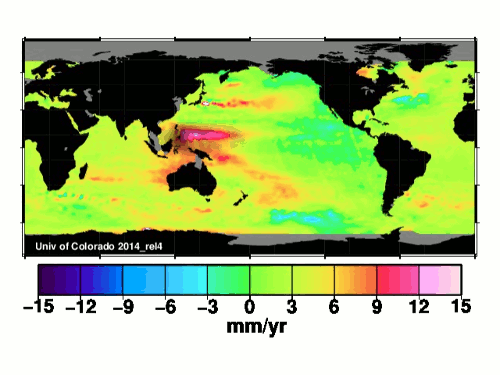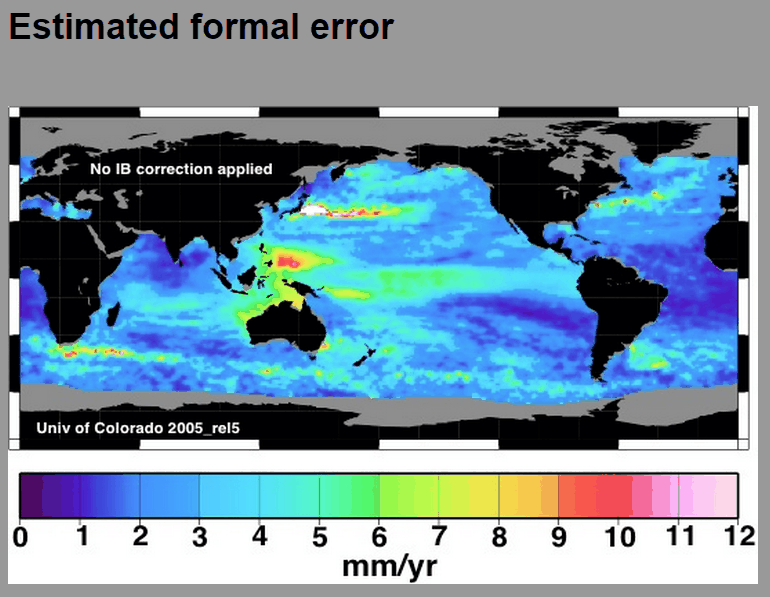According the University of Colorado, sea level is rising much faster than 85% of tide gauges show, and forming a massive mound near the Philippines. Apparently they believe that water likes to pile up in mounds, and to help visualize their BS I created a 3D animation.
And one more minor detail. They used to have the map below on their site, but have removed it. It showed that their error was almost as large as their trend – meaning their data is basically worthless
This complete garbage forms the basis of the IPCC claim that sea level rise suddenly doubled in 1992, when they switched measurement systems.





A massive mound near the Philippines? Now it all makes sense!
Surfs up, dude.
It could be a REALLY slow moving tsunami. Those are also predicted in the man-made global warming scenario, aren’t they? You know… all of those fracking-induced earthquakes.
Let’s see . . the bulge was formed in 1992. At this rate is should hit the west coast of CA in around 123,000 years.
Great animation there, thanks.
So when they try and pull this, in the internet age no less, who is it that they are trying to fool? Congress, for the funding? Each other? There are no competent scientists in the world to shout STOP! Stop the madness. Science has wrecked itself, right in front of our eyes.
+1
How did all these non-scientists get into science? Used to be, only people with a knack for science would excel in it and get jobs. Now, thanks to the Marxist idea that all people are the same, we find thousands of people with zero science aptitude calling themselves scientists and writing total garbage science papers and peer reviewing them.
Same thing happened to music when rap came out…..any idiot with a microphone can claim to be a musician, and art when people like Andy Warhol and Jackson Pollack claimed to be artists by splashing paint around.
http://image.made-in-china.com/2f0j00KeNTPWQnZhku/Water-Slide-Hill-Side-WS-038-.jpg
IPCC = Professional Pedestrians
Changing the subject somewhat… We’ve had four wind turbines collapse in England:
http://www.dailymail.co.uk/news/article-2754679/The-scandal-UKs-death-trap-wind-turbines-A-turbine-built-115mph-winds-felled-50mph-gusts-Dozens-affected-cost-cutting-Why-residents-living-shadow-demanding-answers.html
Further reads on related issues:
FLAGSHIP GERMAN OFFSHORE WIND FARM PROJECT HUMILIATED BY TECHNICAL FAULTS
http://www.breitbart.com/Breitbart-London/2014/09/12/Flagship-German-Offshore-Wind-Farm-Project-Humiliated-by-Technical-Faults
The location of the “bulge” is approximately where the warm waters from ENSO accumulate. I was thinking maybe they got confused, so I went to CU’s website. I found a graph that indicated mean sea level had risen about 70 mm in the last 20 years!
When there is that much confusion, it is best just to leave the area before something explodes….
They’re probably modelling sea level rise using some algorithm involving temperature, temp rises –> sea level rises, it can’t be direct measurements.
But, as usual, they keep making their ridiculous predictions and not seeing the mistake.
They’re *really* unfit for the job! 🙂
Guess they never bothered to read Bob Tisdale’s clear description of ENSO. It’s always 0.5 meter (500mm) higher in Indonesia than on the other side of the Pacific…under normal conditions. Izzat the bulge?
http://bobtisdale.wordpress.com/2014/01/10/an-illustrated-introduction-to-the-basic-processes-that-drive-el-nino-and-la-nina-events/
That’s one hell of an impressive swelling. I’m sold. We’re done for.
Honest.
wait..I have Trenberth on the line…
Yes, Kev. will do
He wants to know if this is the Pacific, or the Atlantic.
whats that Kev ?
Oh. and if it’s one of the Atlantics, which one ?
Tell him it is the Atlantic Falcons.
He will understand….
Have they modelled how many fish species will die out through exhaustion having to swim uphill?
Yep… They applied their bogus Computer model full of assumptions to the entire Datasets… These assumptions place a huge bulge over the Phillippines…
Apparently they don’t check their work…
Gee…that bulge is where they dumped all of Imelda Marcos’ shoes.
The collection was so large it created a gravity anomaly. Well there’s your answer.
Take a look at the tide gauge record for Manila in the Philippines and you will see an offset in 1970 after a big earthquake when the island sank abruptly. The 1901-1069 avg rise was 1.90 mm/yr but after the quake and offset it jumped to 13.4 mm/yr as a result of subsidence. The unusually high Philippine sea level rise is due mostly to subsidence, and is not typical of global sea level rise.
And here is the tide gauge for Manila:
http://tidesandcurrents.noaa.gov/sltrends/sltrends_global_station.shtml?stnid=660-011
If you removed the localized bulge, what would the global rise in sea level be?
Is this not proof that – once again – a “global” phenomenon is a mathematical construct arising from a local phenomenon? That understanding why THAT area is warming/rising is the key to understanding the computational appearance of a global effect?
How can a global CO2 increase in the atmosphere focus its affects on the ocean in one specific area?
Computational reality, not representational reality, stares us in the face: we are experiencing something regional, not global, that needs explanation on a regional, not global level.
Why doesn’t the absence of a strong global signal bother the warmists?
Why doesn’t the absence of a strong global signal bother the warmists?
Because they have the morals of a louse, the conscience of a snake and the integrity of three day old slug slime…
Noting that today is Ivan Pavlov’s birthday made me think about his dogs and just how his experiments on reflexes perfectly describe the reaction of people that make this kind of crap up when they anticipate a grant. .
I was laughing loud on the train, and got some frowning looks. Oh well. Cool graphic but I think the mountains of New Guinea are taller than the mound of ocean.
Indeed the surf is up in the Philippines:
http://www.youtube.com/watch?v=7p5pUjCH3os
The broken cue stick is worse than the hockey stick. With a hockey stick, you can at least play hockey.
As always, Steven, an interesting post. Plus in this case a very captivating animation.
However, you appear to be conflating two things, the trends and a “bulge” in the actual sea level, when you say:
You are correct that UC says the satellites say the sea level is rising faster than tide gauges.
However, the map shows only the trend since 1993. It says nothing about the elevation of the surface of the ocean. In particular, it does NOT say there is a bulge by the Phillippines. It just says it is higher than it was in 1993.
Next, the Pacific Ocean “sloshes” back and forth in its basin in a most complex and long-term manner, forming standing waves in some regions and a lack of tides (amphibole) in certain locations. Since the tidal cycles only repeat every fifty-plus years, a twenty-year record is far too short to say much that is meaningful.
Finally, water like anything else expands when heated so there is some thermal component to the sea level variations.
Having said all that, I fear I don’t believe their data much more than you do. In fact, I just downloaded the data, and I find that the largest sea level rise shown in their data is an astounding 209 mm … which would give a total rise in that gridcell since 1993 of 4.2 metres (about 14 feet). And they claim that there are 52 gridcells that are over 50 mm/year, which is a metre in 20 years … sorry, not believable.
When I see that kind of extreme values, I have to think that they’ve got some sand in their gears …
w.
A trend of 10 mm/year rise is not a standing wave. It is growing taller at a rate of one meter per century. A bulge.
Thanks, Steven. You cannot assume that a trend a) will continue for a century, b) started at 0, or c) has created a bulge today. If the trend started eight inches down twenty years ago, today it would be dead level, no bulge at all.
Regards,
w.
PS—A trend of 10/mm per year over 20 years may certainly represent the upwelling portion of a standing wave with a 50-year period …
The CU maps show a larger trend now than they did a decade ago
And don’t forget … I don’t believe their data either …
w.
A change in the shape of the Geoid is my theory. I’ve just had a play on this :
http://geographiclib.sourceforge.net/cgi-bin/GeoidEval?
and plugging in co-ordinates of 10N, 145E which appears to be right in the middle of your “bulge” shows that the height of the Geoid at that location rose by a massive 1.4m between 1984 and 2008 – that’s a rate of 57mm per year!.
If that sounds a lot, consider that the undulation of the Geoid varies from -106m near the Maldives (the only reason they poke their noses above the ocean surface) to +85m just north of Papua New-Guinea.
Changes in the shape of the Geoid are driven by variations in rock density in the crust and lithosphere caused by processes about which we know the square root of bugger all. However, the area highlighted is very tectonically active so, in theory at least, it may be possible. It also cannot be emphasized enough that if my theory is correct it would have absolutely nothing to do with climate.
“Changes in the shape of the Geoid are driven by variations in rock density in the crust and lithosphere caused by processes about which we know the square root of bugger all”
=====================
Good sentence.
What would these forces do to GRACE measurements?
It’s quite obvious. This is the IPCC’s Battle of the Bulge, a last ditch attempt to reach the Port of An Twerp thereby to stop supplies reaching Allied Scientific Armies as they race to the capital of the Climate Axis heartland!
Not having read the basic article, this may be a stretch, but… It is well known from satellite altimetry that the sea level increases over deep ocean trenches. This occurs because the acceleration of gravity is less than “normal” over these regions due to the increased thickness of the lower density seawater (relative to rocks, etc.) These “mounds” are ‘stable’ because the sea surface attempts to remain at a constant level of gravitational potential.
Reblogged this on CraigM350 and commented:
OMG – they found the missing heat! Now if we can all write cheques or make paypal donations made out to A Gore, I’m sure they will create the Great Anti-Carbon Mallet to smack this ungodly bulge with. This may of course create an enormous tsunami killing hundreds of millions but what the heck these human pests would probably have breathed out carbon pollution anyway. The earth and her chosen messenger, A Gore, will thank us. Now if you’ll excuse me I must jet off to lecture primitives on why they should sacrifice themselves. /sarc
There must be fantastic surfing available off the Philippines down to sea level. Strange that I have not seen any photos or reports of it!
This is great news. My next commercial endeavour is to build a chairlift at the bulge for surfers. Any takers?